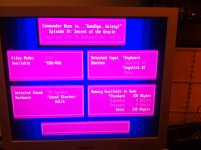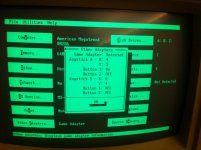Erwin-c64
Member
As some people here might know I just got a IBM 5170, it has an Everex memory card which gives me a total of 1024 KB.
I used the following configuration to load Commander Keen 4:
VGA card (Headland HT208) + Modern TFT
Sergey Adlib Clone
Western Digital MFM controller
LPT Card
AMI Bios (downloaded from minuszerodegrees (Thnx!))
The result is the game locks up the pc at the loading screen and it detects the presence of Joystick 2. (there is no game adapter or joystick port)
I removed the Everex memory card, Adlib-clone, LPT card, replaced the video card with a MDA type.. but no matter what I change that Game Adapter keeps being detected (see that green MSD screenshot where it states Button1 is pressed on Joystick A).
So I figured that AMI Bios might be the cause of this and I replaced it with the Quadtel 286 bios I originally found in the pc. Issue remains the same.
So the question is.. What is causing a Game Adapter to be detected when there is none? Is this normal behaviour? :confused2:

I used the following configuration to load Commander Keen 4:
VGA card (Headland HT208) + Modern TFT
Sergey Adlib Clone
Western Digital MFM controller
LPT Card
AMI Bios (downloaded from minuszerodegrees (Thnx!))
The result is the game locks up the pc at the loading screen and it detects the presence of Joystick 2. (there is no game adapter or joystick port)
I removed the Everex memory card, Adlib-clone, LPT card, replaced the video card with a MDA type.. but no matter what I change that Game Adapter keeps being detected (see that green MSD screenshot where it states Button1 is pressed on Joystick A).
So I figured that AMI Bios might be the cause of this and I replaced it with the Quadtel 286 bios I originally found in the pc. Issue remains the same.
So the question is.. What is causing a Game Adapter to be detected when there is none? Is this normal behaviour? :confused2:


Last edited:
